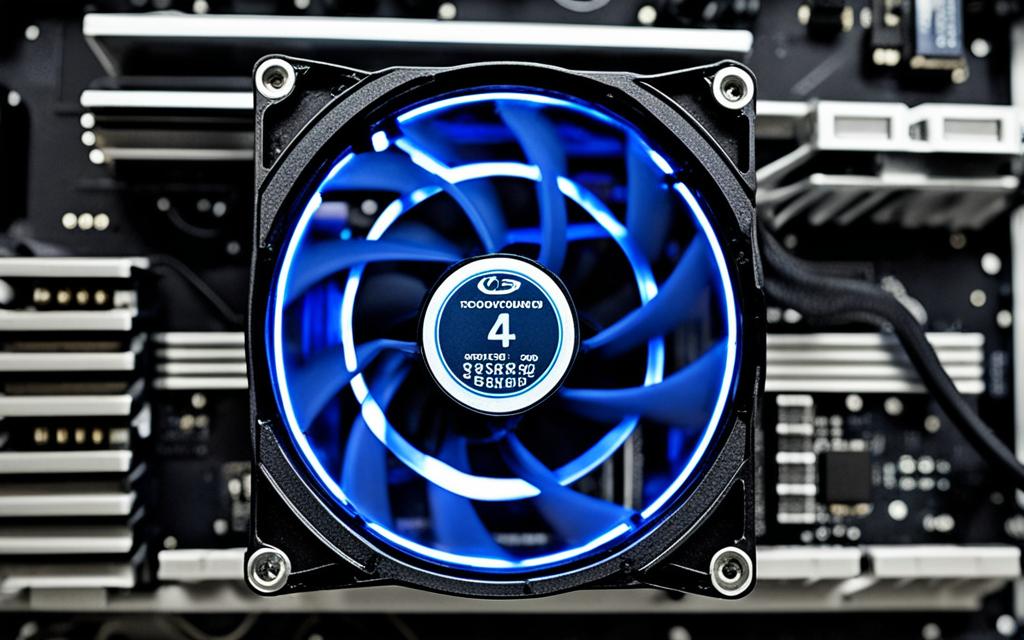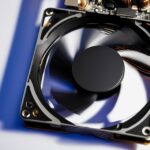Table of Contents
Finding the right RPM for CPU fans is key to good CPU cooling and long system life. Good heat removal boosts your CPU’s work and stops it from getting too hot, which can break it. The best RPM for keeping your CPU cool usually sits between 1000 and 2500 RPM. Experts often suggest keeping it in the range of 1000 to 1500 RPM.
Keeping the right fan speed helps both tech fans and everyday users set up their systems well. It balances cooling power and how much noise is made. Learning to adjust RPM settings can greatly improve how you use your computer. The advice on CPU fan speeds is very important. This article will look at what affects fan speed and the best RPMs for different fan sizes and CPU types1.
Key Takeaways
- The typical CPU fan RPM varies a lot by fan size, with 140mm fans going from 400 to 1200 RPM.
- Optimal fan speeds find a middle ground between cooling ability and keeping noise low, usually between 1000 and 1500 RPM.
- Things like your CPU type, case airflow, and how you cool things down play a big role in finding the right RPM settings.
- Many motherboards now automatically change fan speeds based on how hot things get.
- Taking care of your fan by cleaning and stopping dust buildup is crucial for keeping it running well.
Understanding CPU Fan Functionality
The effectiveness of a CPU fan greatly impacts a computer’s performance. It keeps it running at the right temperature. Each fan works to either pull air in or push it out from the heatsink. This helps get rid of heat. If the fan fails, the CPU may get too hot. This could lead to system crashes and reduce the life of the computer.
The Role of CPU Fans in Computer Cooling
CPU fans are crucial for keeping the processor cool and efficient. They prevent overheating problems like thermal throttling and possible hardware damage. Many motherboards let you monitor and adjust fan speeds. You can use either PWM or voltage control methods2.
Software like SpeedFan or HWiNFO lets you set up custom fan profiles. These can be tailored for different uses, such as gaming or video editing3.
How Fan Size Affects RPM
Fan size and RPM are closely connected. Bigger fans can move the same air at slower speeds. This means they can be quieter. In rooms where noise needs to be low, this is a big advantage. Smaller fans have to spin faster to match the airflow. This can make them noisier and may shorten their lifespan.
The quality of the fan manufacturing matters too. It can influence noise and vibrations at varied speeds2. With the right fan control and software, you can adjust speeds based on temperature. This keeps cooling effective and noise low3.
Common CPU Fan Speeds and Ranges
It’s crucial to understand common CPU fan speeds to keep your system cool and efficient. Fan speeds depend on their size, which influences the RPM. This affects how well they cool your system.
Typical RPMs by Fan Size
Fans of different sizes, like 120mm and 140mm, often work at speeds from 800 to 1800 RPM. Smaller ones, such as 80mm, might speed up from 1200 to 2500 RPM. Exploring typical RPMs for various fan sizes shows most operate well between 1000 and 2500 RPM4. Knowing these ranges helps in choosing the right fan.
Recommended RPM for Different CPU Models
Different CPUs need specific fan speeds, with high TDP ones requiring 1000 to 3000 RPM for best cooling5. For example, the AMD Wraith Prism cooler goes up to 2800 RPM for top performance. It’s vital to select RPMs that match your CPU’s needs to prevent overheating.
Tools like HWMonitor and SpeedFan let you monitor your CPU fan speed in real-time. Adjusting based on these readings can avoid problems5.
Being proactive with common CPU fan speeds helps your equipment last longer and work better. Even in intense gaming or video editing, the right RPM keeps things cool and quiet.
What Is the Ideal RPM for Your CPU Fan?
Finding the right RPM for your CPU fan is crucial for keeping things cool and running smoothly. The ideal CPU fan RPM is usually between 1000 and 2500 RPM. This range helps to keep your computer cool without making too much noise6. It’s important to know the factors influencing fan speed since they greatly affect how fast your fan should run to maintain safe temperatures. Things like the room’s temperature, how much work your CPU is doing, and how well your thermal paste was applied are all key.
Factors Influencing Optimal Fan Speed
Several elements impact the best fan speed for your CPU. Let us look at these factors:
- Ambient temperature—higher room temperatures call for faster RPM to keep cool effectively.
- CPU workload—demanding tasks like gaming might need fans to work near their speed limit, especially quiet ones like Noctua that typically run around 1000 RPM7.
- Thermal design power (TDP) of the CPU—stronger CPUs often require faster fan speeds to get rid of the heat they produce6.
- Type of cooling system in use—different setups may change how the fan should speed up.
Balancing Noise and Performance
It’s important to find a good mix between noise versus performance to keep computing comfortable. When your computer isn’t working hard, keep fan speeds low to reduce noise. But if it heats up, it’s okay to turn the fan faster. Many prefer fans that are quiet and run below 1000 RPM, which still keep the system cool during intense gaming or heavy tasks7. Using software like Core Temp or MSI Afterburner can help you keep an eye on temperatures and adjust fan speeds accordingly. This helps you get the best performance without much noise7.
How Much RPM for CPU Fan?
The right RPM for your CPU fan impacts your computer’s running and stability. It’s key to know the balance in fan speed. Also, you must understand the best RPM for different activities. This ensures good cooling without extra noise.
Understanding the Trade-offs
Finding the ideal mix between cooling and noise is crucial for a great computer experience. Using a high RPM can help get rid of heat during intense use, like gaming or 3D rendering. These activities may need more than 3000 RPM to keep cool84. On the other hand, low RPMs, from 1000 to 2000 RPM, work well for everyday tasks. They keep things quieter.
General Recommendations for Different Use Cases
When deciding on the RPM for your CPU fan, here are some tips based on your activity:
- Gaming and Intensive Tasks: Go for 2500 to 3000 RPM to ensure the best heating control4.
- Casual Use: 1000 to 1500 RPM is enough to cool the system while keeping it quiet.
- Server and Workstation Environments: Standard fan speeds might hit 5000 RPM to tackle higher heat9.
It’s important to watch and change fan speeds as needed. Using BIOS/UEFI settings or third-party software can help you get the right cooling effect. Plus, it can reduce noise84.
Adjusting CPU Fan Speeds
Adjusting the speed of your CPU fan is key for top system running and cooling. There are many ways to control the fan speed. This makes sure computers stay within a safe heat range.
Using BIOS Settings for Fan Control
Modern motherboards’ BIOS settings offer great fan control. You can go to the BIOS to set up how fans react to heat. For example, setting fans to speed up as the CPU gets hotter helps keep it under 70 degrees Celsius10.
With hardware monitoring, BIOS becomes an easy choice for detailed CPU cooling adjustments. It’s ideal for those who want to precisely manage their cooling.
Third-Party Software for Speed Monitoring
For more detailed control, try third-party software like SpeedFan. It adjusts the CPU fan speed, keeping an eye on temperatures and fan work. Automatic adjustments mean your cooling stays perfect without you doing anything10.
Knowing about different fan types—Molex, DC, PWM—helps choose the right software. PWM fans, for example, are better for power and adjustments than Molex fans11. By managing fan speeds well, you can get the right balance between quietness and good cooling. This helps your computer run smoothly.
Maintaining Your CPU Fan for Optimal Performance
Keeping your CPU fan in top shape is key for your computer to work well. Regular cleaning and knowing when to get a new fan can make a big difference. This helps your computer parts last longer and work better.
Cleaning and Maintenance Practices
Dust can block airflow, make your computer hotter and noisier. Here’s how to keep your CPU fan clean:
- Frequency of cleaning: Clean your CPU fan every few months, more so if it’s dusty around.
- Use of compressed air: Carefully use a can of compressed air to remove dust without hurting the fan blades.
- Heat sink maintenance: Clean the heat sink often to stop overheating. Overheating affects how noisy and effective your fan is7.
- Monitor fan performance: Check fan speeds and temperatures with software to see how well it’s doing during use.
By cleaning your CPU fan often, you can help stop overheating. Research shows about 60% of overheating comes from not looking after the fan properly12.
When to Replace Your Fan
Knowing when to get a new fan is crucial for keeping your computer cool. Look for these signs:
- Excessive noise: If your fan gets louder, it might mean it’s wearing out and needs a change.
- Overheating: Frequent overheating under normal use could mean your fan is failing12.
- Decreased performance: A drop in your computer’s performance could be due to poor cooling from a bad fan.
Following these tips for fan replacement can help your CPU last 30% longer than ignored fans12.
Conclusion
Knowing the right RPM for CPU fans is key to keep a cooling system working well without much noise. It’s usually best to have CPU fans running between 800 and 1500 RPM. Yet, for high-demand tasks, speeds might need to go up to 3000 RPM13. Following these recommended speeds can help avoid overheating. This prevents damage and makes your computer parts last longer14.
It’s also important to regularly take care of your system and adjust the fan speed when needed. The right fan speed can depend on how hot your CPU gets, the room’s temperature, and the CPU type. Always check the guidelines from the fan’s manufacturer8. Finding the perfect balance between cooling and keeping the noise down ensures your computer runs well for a long time.
FAQ
What is the optimal RPM for my CPU fan?
The best RPM for CPU fans is usually half to two-thirds of their max RPM. This balance keeps everything cool and not too noisy.
How does fan size affect RPM and cooling efficiency?
Big fans push more air and can be slower and quieter. Small fans need to spin faster, which might make more noise, for good airflow.
What are the common RPM ranges for different sizes of CPU fans?
A 140mm fan often runs at 400 – 1200 RPM. Meanwhile, an 80mm fan ranges from 800 – 2500 RPM. The size affects how fast it needs to spin.
How can I determine the right RPM for my specific CPU model?
The best RPM depends on your CPU, like an AMD Wraith Prism or Intel Laminar RM1. They vary from 600 to 2800 RPM, based on what cooling they need.
What factors influence the RPM needed for effective cooling?
Things like the room’s temperature, how hard your CPU is working, and thermal paste use affect the needed RPM for the best temperature control.
How do I balance noise levels with cooling performance?
For games or heavy tasks, keep the RPM high to cool the CPU. For everyday use, lower RPMs will make your system quieter.
How can I adjust the speeds of my CPU fans?
Change your CPU fan speed in the BIOS settings. Or use software like SpeedFan to monitor and adjust based on temperature.
What are the best practices for maintaining my CPU fan?
Keep your fan clean by dusting it every few months. Watch out for signs it’s time to replace it, like a lot of noise or bad cooling.
Source Links
- https://www.cgdirector.com/cpu-fan-rpm-guide/ – Guide to CPU FAN RPM – What’s a good CPU FAN Speed?
- https://www.overclock.net/threads/how-do-fans-report-rpms.1316202/ – How do fans report RPM’s?
- https://www.electronicshub.org/cpu-fan-speed/ – How To Control CPU Fan Speed?
- https://softwareg.com.au/blogs/computer-hardware/normal-cpu-fan-speed-rpm – Normal CPU Fan Speed RPM
- https://ms.codes/en-ca/blogs/computer-hardware/normal-cpu-fan-speed-rpm – Normal CPU Fan Speed RPM
- https://softwareg.com.au/blogs/computer-hardware/how-many-rpm-should-my-cpu-fan-be – How Many RPM Should My CPU Fan Be
- https://www.mmo-champion.com/threads/2580273-What-should-be-the-normal-fan-speed-of-a-gaming-PC – Thread: What should be the normal fan speed of a gaming PC.
- https://www.auslogics.com/en/articles/quick-tips-how-to-control-cpu-fan-speed-on-windows-pcs/ – Quick Tips: How to Control CPU Fan Speed on Windows PCs
- https://www.lenovo.com/us/en/glossary/rpm/ – Why is RPM Important in Computing & Technology?
- https://www.lifewire.com/control-cpu-fan-on-windows-10-4776311 – How to Control the CPU Fan on Windows 10
- https://dotesports.com/general/news/how-to-control-cpu-fan-speed – How to Control CPU Fan Speed | How to Manually Control Your PC Fan
- https://rog-forum.asus.com/t5/overclocking-tweaking/should-the-cpu-fan-run-faster-or-slower-than-the-case-fans/td-p/445504 – Should the CPU fan run faster or slower than the case fans?
- https://softwareg.com.au/blogs/computer-hardware/good-rpm-for-cpu-fan – Good RPM For CPU Fan
- https://ms.codes/blogs/computer-hardware/normal-cpu-fan-speed-idle – Normal CPU Fan Speed Idle








